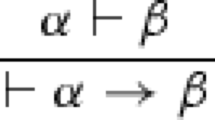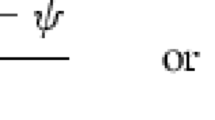Abstract
Dave Ripley has recently argued against the plausibility of multiset consequence relations and of contraction-free approaches to paradox. For Ripley, who endorses a nontransitive theory, the best arguments that buttress transitivity also push for contraction—whence it is wiser for the substructural logician to go nontransitive from the start. One of Ripley’s allegations is especially insidious, since it assumes the form of a trivialisation result: it is shown that if a multiset consequence relation can be associated to a closure operator in the expected way, then it necessarily contracts. We counter Ripley’s objection by presenting an approach to multiset consequence that escapes this trap. This approach is multiple-conclusioned in a heterodox way, for multiple succedents are given a conjunctive, rather than a disjunctive reading. Finally, we address a further objection by French and Ripley to the effect that the informational interpretation of sequents in (affine) linear logic does not motivate cut.
Similar content being viewed by others
Notes
We disagree with Harman’s famous claim (Harman 1986) that belief revision has nothing to do with deduction. We tend to think that a theory of belief revision should include as an integral part a theory of deductive reasoning from undischarged assumptions. This is, however, a topic that would deserve a paper of its own.
In the past, while preaching relevant logicians about the virtues of linear logic when it was still being paid relatively little attention in logico-philosophical circles, one of us replaced the ‘multiplicative-additive’ dichotomy with the more familiar ‘intensional-extensional’ distinction, of Lewisian and Belnapian origin. We’ll stick to that convention here.
Although the restriction to finitary consequence relations mainly serves the purpose of simplifying our exposition, it is a very natural one: as our goal is to study resource-sensitive reasoning, it would not be plausible to assume that we can have an actually infinite amount of tokens of some resource.
It could be objected that we are not being true to the letter of the original Ripley argument, as he was not assuming finitarity. However, as we will see later, whether or not we assume this extra condition is immaterial for his point.
Thanks to Dave Ripley for prompting us to clarify this point.
Note that this issue is already present in the ‘classical’ inflated context of the previous section: an infinite union of finite sets need not be finite; i.e., an ‘inflated’ counterpart of a theory would be a collection of all its finite subsets.
The approach taken in Mares and Paoli (2014) favours \(\vdash _{\mathbf {LL}}\) over \(\vdash _{\mathbf {ALL}}\) because it is motivated by the desire to suggest a uniform solution to truth-theoretical paradoxes and to paradoxes of implication, where relevance is a crucial ingredient. In so far as we are only interested in the former class of paradoxes, we can happily take monotony on board. As French and Ripley (2015) are ready to admit, there are perspicuous monotonic notions of information extraction. Whenever the appropriate question is not “Are my premisses exactly the resources I need to extract the information in my conclusions?”, but rather “Have I got in my premisses enough resources to extract the information in my conclusions?”, it would seem as though a monotonic relation can do the job. Therefore, \(\vdash _{\mathbf {LL}}\) will be left in the background in what follows.
An option would be to say that from \(\alpha \rightarrow \beta \) you will always get some information state x such that either \(x\vDash \lnot \alpha \) or \(x\vDash \beta \) (Mares 2004). It would be interesting to explore whether and to what extent the considerations that follow can be reconciled with this suggestion.
This use of simple transitivity could be questioned. If \(a\sqsubseteq \bullet \left( \lnot w,z\right) \) is just a fancy way of writing \(\circ (w,a)\sqsubseteq z\), we don’t have a relevant fact in which a on its own is the first argument of the information-extraction relation. If this objection is correct, we have not really done away with the “complex dance of side information”, but only with the “complex dance of modes of combination”.
In Sambin’s basic logic (Sambin et al. 2000), only two metalinguistic modes of combinations are used: ‘and’ and ‘yields’. This proposal, like the present one, avoids the recourse to a metalinguistic ‘or’. We will not enter into a comparison of these two approaches.
Došen view of multiple conclusion arguments as enthymematic arguments where some (false) alternative conclusions are omitted (Došen 1989) can also be seen as a way of denying T2, although it has some similarities with the proposal that follows.
The signs are meant to express the speech acts of assertion and denial.
Modulo some niceties. For example, \(\lnot \left( p\otimes q\right) \) and \(\lnot p\oplus \lnot q\) are the same formula in the language of \(\mathcal {ALL}_{1}\), and distinct interderivable formulas in the language of \(\mathcal {ALL}_{2}\).
To the extent that one-sided sequent calculi are not, strictly speaking, multiple conclusion proof system, T3 above needs to be qualified as well.
The relevance and appropriateness of \(\vdash _{\mathbf {ALL}^{*}}\) can be questioned on the ground that the rules of certain logical operators, like intensional disjunction, crucially require (disjunctive) multiple conclusions. The tension is particularly salient if these rules are viewed, in an inferentialist perspective, as meaning-determining. However, \(\vdash _{\mathbf {ALL}^{*}}\) is perfectly apt to express the introduction rule for \(\oplus \) as a version of conditional proof, whose premiss has one disjunct in the succedent and the dual of the other disjunct in the antecedent. Also observe that this rule does not fail the separation property (Wansing 2000) because the map that sends a formula (in particular, a variable) to its De Morgan dual is not a connective.
References
Avron, A. (1988). The semantics and proof theory of linear logic. Theoretical Computer Science, 57(2–3), 161–184.
Avron, A. (1991). Simple consequence relations. Information and Computation, 92, 105–139.
Beall, J. C., & Murzi, J. (2013). Two flavors of Curry paradox. Journal of Philosophy, 110(3), 143–165.
Belnap, N. D. (1982). Display logic. Journal of Philosophical Logic, 11, 357–417.
Blizard, W. D. (1989). Multiset theory. Notre Dame Journal of Formal Logic, 30(1), 37–66.
Blok, W. J., & Jónsson, B. (2006). Equivalence of consequence operations. Studia Logica, 83(1–3), 91–110.
Cintula, P., Gil Férez, J., Moraschini, T., & Paoli, F. An abstract approach to consequence relations. (in preparation).
Došen, K. (1989). Logical constants as punctuation marks. Notre Dame Journal of Formal Logic, 30, 362–381.
Dummett, M. (1991). The logical basis of metaphysics. Cambridge: Harvard University Press.
French, R., & Ripley, D. (2015). Contractions of noncontractive consequence relations. Review of Symbolic Logic, 8(3), 506–528.
Galatos, N., Jipsen, P., Kowalski, T., & Ono, H. (2007). Residuated lattices: An algebraic glimpse on substructural logics. Amsterdam: Elsevier.
Girard, J.-Y. (1987). Linear logic. Theoretical Computer Science, 50, 1–102.
Haack, S. (1982). Dummett’s justification of deduction. Mind, 95, 216–239.
Harman, G. (1986). Change in view. Cambridge: MIT Press.
Hinnion, R., & Libert, T. (2003). Positive abstraction and extensionality. Journal of Symbolic Logic, 68(3), 828–836.
Mares, E. (2004). Relevant logic. Cambridge: Cambridge University Press.
Mares, E., & Paoli, F. (2014). Logical consequence and the paradoxes. Journal of Philosophical Logic, 43(2), 439–469.
Paoli, F. (2002). Substructural logics: A primer. Dordrecht: Kluwer.
Restall, G. (2000). An introduction to substructural logics. London: Routledge.
Restall, G. (2005). Multiple conclusions. In P. Hájek, et al. (Eds.), Logic, methodology and philosophy of science: Proceedings of the twelfth international congress (pp. 189–205). London: Kings’ College Publications.
Ripley, D. (2013). Paradoxes and failures of cut. Australasian Journal of Philosophy, 91(1), 139–164.
Ripley, D. (2014). Why I am not a noncontractivist, talk given at the workshop on Current Trends in the Philosophy of Logic, Rome, June 21
Ripley, D. (2015a). Comparing substructural theories of truth. Ergo, 2(13), 299–328.
Ripley, D. (2015b). Contraction and closures. Thought, 4(2), 131–138.
Rumfitt, I. (2000). Yes and no. Mind, 109(436), 781–823.
Sambin, G., Battilotti, G., & Faggian, C. (2000). Basic logic: Reflection, symmetry, visibility. Journal of Symbolic Logic, 65, 979–1013.
Schütte, K. (1950). Schlussweisen-Kalküle der Prädikatenlogik. Mathematische Annalen, 123, 166–186.
Shapiro, L. (2011). Deflating logical consequence. Philosophical Quarterly, 61(243), 320–342.
Shoesmith, D. J., & Smiley, T. J. (1978). Multiple conclusion logic. Cambridge: Cambridge University Press.
Singh, D., Ibrahim, A. M., Yohanna, T., & Singh, J. N. (2008). A systematization of fundamentals of multisets. Lecturas Matemáticas, 29, 33–48.
Slaney, J. (1990). A general logic. Australasian Journal of Philosophy, 68(1), 74–88.
Smiley, T. J. (1996). Rejection. Analysis, 56, 1–9.
Steinberger, F. (2011). Why conclusions should remain single. Journal of Philosophical Logic, 40(3), 333–355.
Tennant, N. (1997). The taming of the true. Oxford: Clarendon Press.
Troelstra, A. S. (1992). Lectures on linear logic. Stanford: CSLI Publications.
Wansing, H. (2000). The idea of a proof-theoretic semantics. Studia Logica, 64, 3–20.
Weir, A. (2015). A robust non-transitive logic. Topoi, 34(1), 97–107.
Zardini, E. (2011). Truth without contra(di)ction. Review of Symbolic Logic, 4, 498–535.
Acknowledgments
We thank Dave Ripley and Charlie Donahue for their insightful comments on a first draft of this paper, which led to substantial improvements. We are also grateful to the guest editor of this special issue and to two anonymous referees for their extremely useful observations. This project has received funding from the European Union Horizon 2020 research and innovation programme under the Marie Skłodowska–Curie grant agreement No. 689176. The first author also gratefully acknowledges support from project GA13-14654S of the Czech Science Foundation and of RVO 67985807. The second author gratefully acknowledges support from Regione Autonoma Sardegna, L.R. 7/2007, Project CRP-78705, ‘Argumentation and Metaphor’.
Author information
Authors and Affiliations
Corresponding author
Appendix: The sequent calculi \(\mathcal {ALL}_{2}\) and \(\mathcal {ALL}_{1}\)
Appendix: The sequent calculi \(\mathcal {ALL}_{2}\) and \(\mathcal {ALL}_{1}\)
The calculus \(\mathcal {ALL}_{2}\) is formulated in a language containing the connectives \(\otimes \) (intensional conjunction), \(\oplus \) (intensional disjunction), \(\sqcap \) (extensional conjunction), \(\sqcup \) (extensional disjunction), \(\lnot \) (negation). Intensional implication \(\rightarrow \) and extensional implication \(\leadsto \) are respectively definable as \(\alpha \rightarrow \beta =\lnot \alpha \oplus \beta \) and \(\alpha \leadsto \beta =\lnot \alpha \sqcup \beta \). \(\mathcal {ALL}_{2}\)-formulas are defined as usual, while \(\mathcal {ALL}_{2}\)-sequents are pairs of finite or empty multisets of \(\mathcal {ALL}_{2}\)-formulas. The postulates of the calculus follow:
The calculus \(\mathcal {ALL}_{1}\) is formulated in a language containing the connectives \(\otimes \) (intensional conjunction), \(\oplus \) (intensional disjunction), \(\sqcap \) (extensional conjunction), \(\sqcup \) (extensional disjunction), but no negation. \(\mathcal {ALL}_{1}\)-formulas are assembled from literals of the form p or of the form \(\lnot p\) (for p a variable of the language) by iterated application of the connectives. A negation connective can be introduced into the metalanguage by stipulating the following inductive clauses for complex negated formulas:
\(\mathcal {ALL}_{1}\)-sequents are finite or empty multisets of \(\mathcal {ALL}_{1}\)-formulas. The postulates of the calculus follow:
Rights and permissions
About this article
Cite this article
Cintula, P., Paoli, F. Is multiset consequence trivial?. Synthese 199 (Suppl 3), 741–765 (2021). https://doi.org/10.1007/s11229-016-1209-7
Received:
Accepted:
Published:
Issue Date:
DOI: https://doi.org/10.1007/s11229-016-1209-7




